25 of the best and fastest 2021 aero road bike

25 of the best and fastest 2021 aero road bikes: wind-cheating bikes with an extra turn of speed
The latest aerodynamic bikes are slipperier than ever and new technologies have improved comfort
by MAT BRETT
The latest aero road bikes are quicker than ever before - and also more comfortable. Find out all you need to know in our complete guide to the fastest, most aerodynamic road bikes.
In just a few years aero road bikes have gone from The Next Big Thing to a mainstream bike option. The latest models have been tweaked to be faster than ever, according to the manufacturers, and to alleviate the harsh ride that characterised some early aero bikes.
With elongated tube shapes and other wind-cheating features, aero road bikes provide a small but handy speed boost.
Sleek shapes make for a distinctive look.
Recent aero road bikes have alleviated the harsh ride that plagued some early models, thanks to improved use of materials.
Many 2021 aero bikes are wind-tunnel re-imaginings of bikes previously considered lightweight all-round and climbing models; it seems you can have it all.
Frame aerodynamics is still a marginal gain; if you're wearing flappy clothes an aero bike is a waste of money.
Updated July 1, 2021
First Published November 24, 2016
Welcome to the latest edition of our buyer's guide to aero road bikes. Find out all you need to know, plus road.cc'sk of the best available.
More about road.cc buyer's guides.
25 of the best aero road bikes for 2021
The latest aero bikes
Pinarello Dogma F — £11,000
Specialized Tarmac SL7 — £4,500 - £11,750
Canyon Aeroad 2021 — £3,699 - £9,749.00
Trek Émonda 2021 — £2,500.00 - £10,700.00
Giant TCR Advanced SL 0 Disc 2021 — £9,999
Basso Diamante SV 2021 — £3,899.00 (frameset)
Look 795 Blade RS Disc Red AXS 2021 — £10,450.00
Merida Reacto 2021 — £2,250 - £9,000
Scott Foil 2021 — £3,959-£8,899
Lapierre Aircode DRS 2021 – £2,999-£6,999
Factor Ostro VAM – £7,800 - £9,250
Wilier Cento10 SL 2021 – £3,240 - £5,860.00
BMC Teammachine SLR One 2021 — £5,000 - £10,499
Continuity aero — bikes that are substantially unchanged but still worth a look
Trek Madone 2021 — £4,600-£13,200.00
Orro Venturi STC Ultegra 2021 — £2,699.99
Cannondale SystemSix 2021 — £5,000.00 - £10,500.00
Orbea Orca Aero 2021 — £3,169 - £5,459
Bianchi Aria Disc 2021 — £3,309.99 – £3,789.99
3T Strada Pro — £2,425.00
Colnago Concept — £3,499.95 (frameset)
Storck Aerfast3 Pro — from €4,999.00
Cervelo S5 Ultegra Di2 Disc 2021 — £8,779
Ridley Noah Fast Disc Ultegra Di2 2021 — £7,899
Cannondale CAAD13 Disc 105 2021 — £2,250 - £3,000
Giant Propel 2021 — £2,399 - £6,999
Bianchi Oltre XR4 Disc 2021 – £5,889-£7,680
Aero road bikes essentially draw aerodynamic features from time trial bikes into a road frame, and balance the demands of weight and stiffness into a package that, on paper, looks to be the ideal all-round choice.

At any decent speed, most of your effort goes into overcoming air resistance, so reducing a bike's drag means you'll go faster, or ride at any given speed with a lower power output. Who doesn't like the sound of that?
Most of your air resistance comes from your body rather than your bike. Wearing non-flappy clothing will help, as will losing weight. But the 20% or so of air resistance from your bike is enough for engineers and designers to focus on making road frames and products more slippery through the air. In the pro peloton aero road bikes have been quickly adopted, where the margins of victory are very slim and there has been a focus on gaining ever smaller performance gains over the years.
Weight, or the lack of it, used to be the main driving force of frame development. Along with stiffness, it was a cornerstones of bike design. These days most bikes are light, many well below the UCI’s 6.8kg weight limit (which doesn’t affect non-racers anyway), and come with more stiffness than is sometimes comfortable.
All that has made aerodynamics more important. Specialized has built its own wind tunnel, for example, and most manufacturers are testing in other facilities. Nevertheless, aero road bikes haven't converged on a perfect, slippery shape. Different engineers prioritise different ways of improving aerodynamics but there are shared design trends: skinny, aerofoil-shaped tubes, integrated brakes, and internal cable routing.
Let's take a look at the latest aero offerings.
The latest aero bikes

With the ten grand psychological barrier well and truly smashed in the last couple of years, brands like Pinarello are taking off into the financial stratosphere with ultra-high-tech frames and the latest electronic shifting, in this case SRAM's top-level Red eTap AXS 12-speed groupset.
Pinarello says the latest Dogma is "a bike that is perfect for every type of rider and every terrain, because real-world riders aren’t specialised,” says Pinarello. “You need a bike that can climb and descend with equal flair, attack every corner and make every watt count on the finishing straight. The Dogma F is designed to do just that, no matter the circumstances.”
As always with a new model, it's claimed to be lighter, stiffer and more aerodynamic than the previous version, though the improvements here are relatively small. Notably, the disc brake Dogma is supposed to be aerodynamically better than the rim brake bike for the first time.
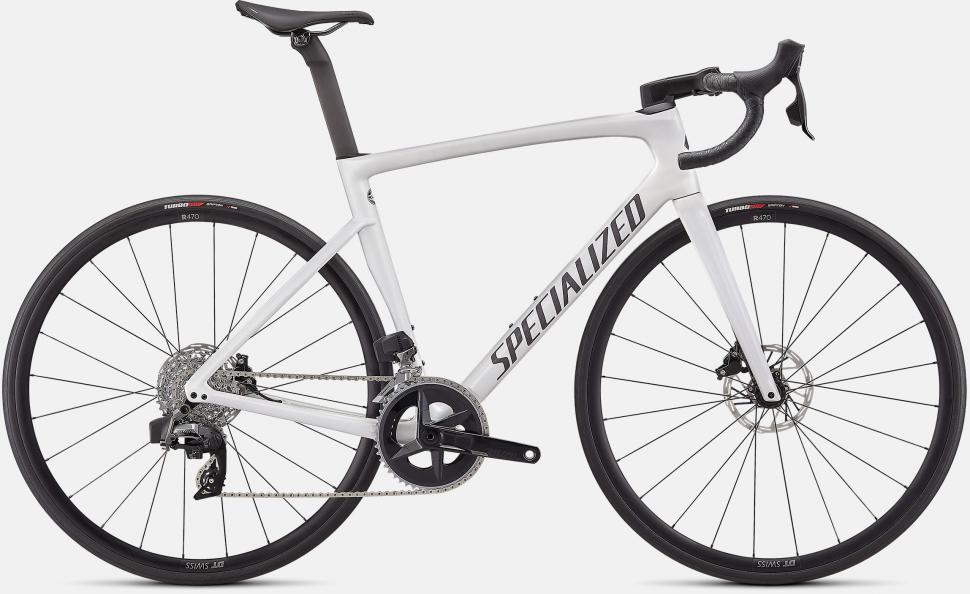
It must be July, because it's already 2022 in model year terms, at least as far as Specialized is concerned. The Tarmac SL7 range for 2022 includes the Tarmac SL7 Comp Rival, above, with SRAM's new Rival eTap AXS wireless electronic shifting. Not only is it the cheapest Tarmac SL7, it undercuts the Tarmac SL7 Expert with Shimano Ultegra Di2 by £750 despite a very similar spec.
Otherwise the Tarmac SL7 typifies one of the themes of bike launches for 2021: the merging of light weight and aerodynamic features. Flagship models have trimmed both grams of mass and grams of aero drag as manufacturers perhaps come to realise that not everyone is going to buy both an eight grand aero bike and an eight grand lightweight bike.
Specialized is therefore bang on trend here with the Tarmac which sees aero improvements that they say make it as slippery as their previous Venge aero bike. And putting their money where their mouth is, they've discontinued built up versions of the Venge; it is now available only as a frameset.
But many Venge features, including tube shapes and the S-Works Aerofly II handlebar, carry over to the Tarmac SL7, and the bike's wind-cutting intentions are assisted by new Roval wheels and a raft of other changes from the previous Tarmac.

Canyon finally released a new version of the Aeroad in late 2020 after a period of anticipation so intense some Canyon fans resorted to stickering-up generic aero frames as the 'new' Aeroad.
It was worth the wait, according to road.cc technical editor Mat Brett who says "this aero road bike is an absolute belter whether you’re flat-out sprinting, haring down your favourite descent or tackling the steepest climb in your area, and you can’t say that about every bike of this kind."
The top model has Canyon's new Aeroad 065 frame, of course, plus a full Campagnolo Super Record EPS groupset and Campagnolo Bora One wheels, but that's not all. Canyon has introduced a width-adjustable handlebar for the top models of the new Aeroad that also allows the bar to fold for easier packing into a flight case. Clever stuff.

The Émonda line was formerly Trek's as-light-as-possible climbing bike, but like the Specialized Tarmac it's had an aero makeover for 2021. Trek says the new bike is 60 seconds per hour faster on the flat than the previous version, and in particular has been optimised for climbing speed.
Adding more material to create aero tube shapes unavoidably adds weight, so Trek developed a new carbon fibre grade called OCLV 800 Series to keep the weight of the top-of-the-range Émonda SLR down.
Trek's target was to make a bike that would be fast up the famous Tour de France climb of l'Alpe d'Huez and to that end they overhauled the handlebar and stem as well as introducing new tube shapes. The new Bontrager Aeolus RSL VR-C handlebar/stem is a key development, along with new Bontrager Aeolus wheels.

"Eh? Isn't the TCR a conventional lightweight road bike?" you're asking. Not any more. Like the Trek Émonda and Specialized Tarmac SL7, the latest TCR has been taken for a ride down Aero Alley where its appeal as a light bike has been thoroughly blended with wind-cheating features and tube shapes.
The Propel remains the true aero road bike in the range but Giant says that every tube shape on the TCR was analysed, engineered and tested to create an overall structure with significantly lower drag than previously at a wide range of yaw angles.
The TCR now features truncated ellipse tube profiles – the leading edge and sides are designed to reduce drag while the trailing edge is cut off square to reduce weight and avoid handling issues – and the huge down tube (up to 65mm in diameter) is designed to work aerodynamically with a water bottle in place.

The 2021 Diamante SV features a revised geometry and larger tyre clearance for a more compliant ride that Basso says also makes the bike faster on rough roads. Basso claims that there is also an aero boost with the new frame thanks to the OpenFlow fork design.
We reviewed the old model, which still had exposed cables and rim brakes, in early March and while we loved the ride quality, we did note that the bike felt a little dated when compared with the competition. No such criticism can be levelled at this incarnation.
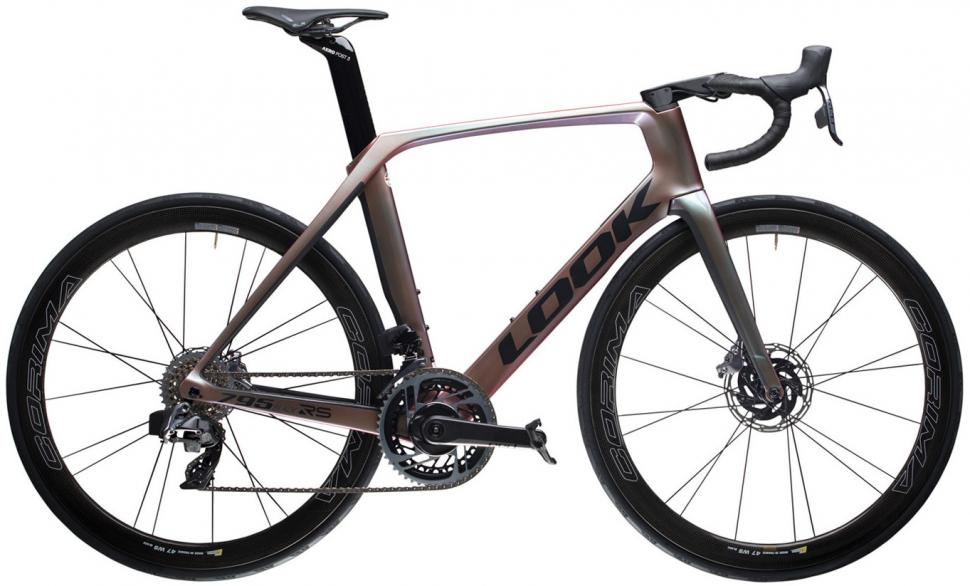
The latest version of Look's top-end speed weapon boasts disc brakes, inevitably, though a rim version is still available, and a chameleon paint finish that looks like a different colour depending how the light falls on it.
But the goodness here is more than skin deep. Look says the 2021 Blade RS is 300g lighter than the previous version thanks to higher-strength carbon fibre and a new manufacturing process that involves a polystyrene inner mould around which the carbon cloth is laid up. A new seatpost brings the total weight-saving up to 420g.
Look says that the new layup enhances comfort too, helped by clearance for 30mm tyres. Overall, it's "the fastest, most comfortable and most versatile bike LOOK has ever designed," the company says.

It's a case of tweaks rather than big changes for Merida's Reacto aero bike range in 2021, as Merida themselves admit: "With its predecessor delivering almost unrivalled aerodynamic performance we had to focus on making small incremental improvements."
Those small improvements include a frame and fork with room for tyres up to 30mm wide; improved cable routing that tucks everything away in the handlebar and stem; a new one-piece bar and stem on the Reacto Team-E, 9000-E and 8000-E; and tidier seat clamp and through-axles. It's also disc-only this year; rim-brake Reactos are no more.
After blasting around for a few weeks on the Reacto Team-E our Liam pronounced it "Very fast, very stiff and very fun to ride – an excellent race bike".

Wilier has introduced the entirely new Filante SLR for 2021, a model that has been designed with “real world aerodynamics” in mind. It’s a disc brake bike for electronic groupsets only, with the hoses and wires routed internally, and Wilier claims a frame weight of just 870g.
Like many other brands, Wilier uses airfoils designed by NACA (National Advisory Committee for Aeronatics) as the basis for Filante SLR’s tube profiles, as it did for the Cento10Pro aero road bike. The difference, though, is that the cutoff at the rear of the tube is more rounded, and Wilier says that this helps the bike maintain good aero characteristics in a wide range of circumstances.
Wilier also uses fork legs and seatstays that sit very wide of the wheel and tyre to reduce turbulence and drag, and the brake hoses and shift wires (on models that use them) run internally through a one-piece handlebar/stem.

The Foil arguably kicked off the whole aero road bike trend, bringing aerodynamic design that was once the preserve of time trial bikes to regular road bikes. Scott added disc brakes in 2018 and has launched a new version for 2021 with integrated cable routing for both mechanical and electronic shifting – because external cables are just so last year on any high-end road bike, never mind an aero model.
Scott says that this has been achieved without any compromise to shifting or braking quality, or to front end stiffness. It also says that it is surprisingly easy to change cables and maintain the new design.
The fork had to be completely redesigned to allow fully integrated cable routing and to reduce drag further. The new fork comes with space for 30mm-wide tyres, increased clearance being one of the big trends of the moment.
The bike uses a one-piece Syncros Creston IC SL handlebar/ stem, as already found on high-end Addicts.
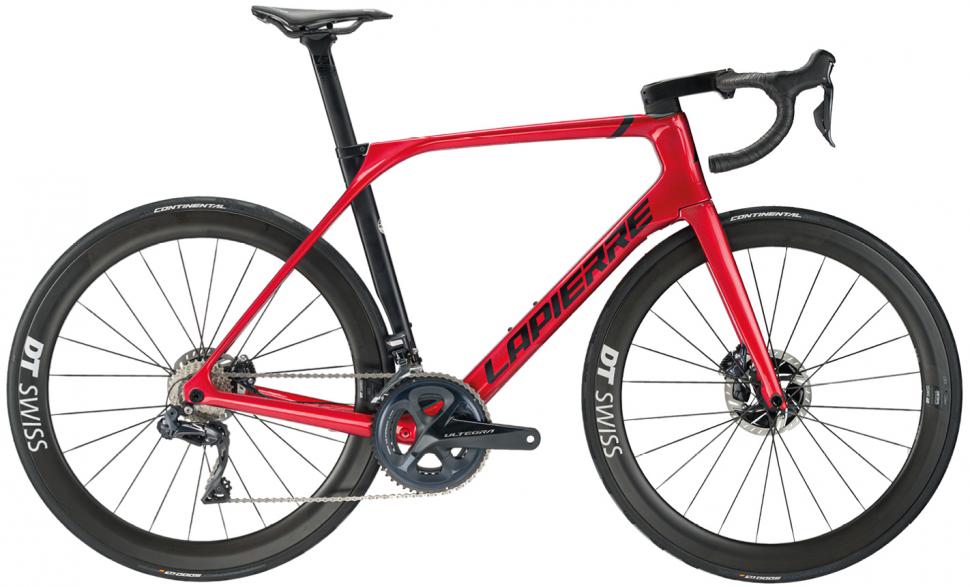
French brand Lapierre tweaked its Aircode bikes for 2018, but for 2021 there's a whole new Aircode DRS platform which incorporates 2021's standard list of aero bike improvements: better aerodynamics, integrated cables and space in the frame for fatter tyres, though Lapierre have only gone up to 28mm.
Lapierre have also modified the riding position on the new Aircode DRS bikes with a steep seat angle and longer reach so you're in a more aerodynamic position on the bike, though of course you're going to need to be sufficiently flexible to handle it. Time for a bit of yoga maybe?
Like so many of 2021's aero bikes, the Aircode DRS is disc-only. Looks like the siren call of hiding brake hoses away in the frame beats the demands of traditionalists for rim brakes.
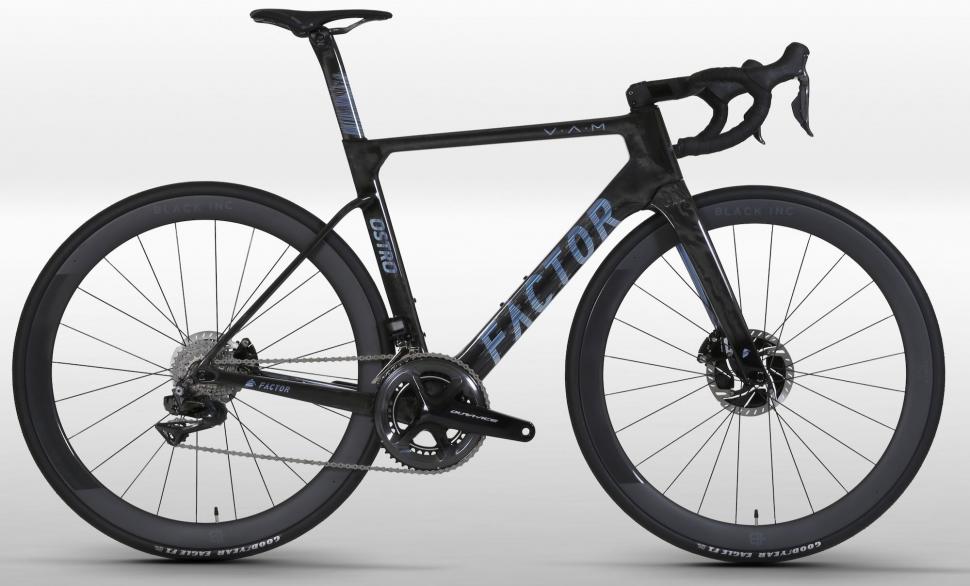
The Ostro is another completely new for 2021 model that’s designed to combine a light weight with aerodynamic efficiency. It is available exclusively for disc brakes and electronic shifting and, like most new race bikes these days, it comes with fully internal cable routing. Factor sees the Ostro as “the ultimate all-rounder” for mixed terrain and, with clearance for tyres up to 32mm wide, even cobbles.
The frame uses medium-depth tube profiles that are derived from NACA (National Advisory Committee for Aeronautics) shapes. Factor says that these are difficult to manufacture but the fact that it owns its own factory (as opposed to getting its frames made by a third party) allows it to use an expensive and time-consuming process without passing on the cost to consumers.
Factor claims a weight of 780g for a 54cm Ostro frame (painted) and says that this easily builds into a 6.8kg complete bike (the UCI’s minimum weight for racing) with a power meter and mid-depth aero Black Inc Forty Five wheels fitted (Black Inc being Factor’s own brand).
Factor says that the Ostro offers a smooth ride courtesy of slim seatstays that join the seat tube low down, and a carbon layup that has been designed with compliance in mind.

As well as the Filante (above), Wilier has added the Cento10 SL to its aero bike range for 2021, available in disc brake and direct mount rim brake versions.
The new Cento10SL is a replacement for the Cento10Air which started its life as Wilier’s range-topping road bike but had gradually become the mid-level option with the Cento10Pro above it.
Wilier has used a cheaper carbon layup for this SL version which adds a bit of weight over the Pro model, but it keeps the NACA (National Advisory Committee for Aeronautics) tube shapes. Wilier doesn’t make any specific aero claims about the new SL bike but does claim it offers similar aero properties to the Pro design.
The use of narrow headset bearings allows the routing of four cables through the head tube. That means that both mechanical and electronic shifting systems are hidden neatly out of the wind.
The cables are routed through a carbon cover on the underside of the alloy stem; they’re only exposed between the end of your handlebar tape and the point where they duck under the cover.
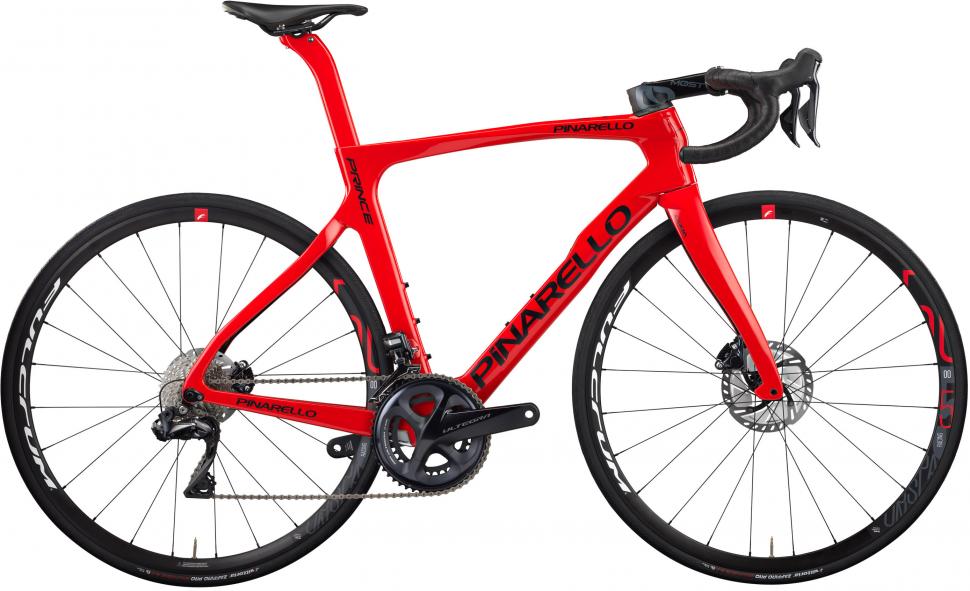
Pinarello has redesigned the Prince road bike for 2021, with a geometry refresh that makes it slightly less aggressive than before – which is unusual for a bike with aero credentials. It comes into the UK as a disc brake-only bike.
The frame is still offered in two grades of carbon, with the standard model getting Toray T700 and the FX version bumping things up to Toray T800.
Borrowing aero trickle-down technology from the Dogma F12, the new Prince features recessed bottle cage placement in the down tube which Pinarello claims minimises the aerodynamic impact of the water bottle.
Pinarello also says that “the introduction of the Dogma F12’s trademark ForkFlaps along with a more aggressive Onda fork shape improves stable air flow over the bike.”
The front end gets the integrated cable treatment that has almost become standard on new race bikes over the last year. Pinarello claims that its TICR (Total Internal Cable Routing) system results in an 85% reduction in cable and wire aerodynamic drag.

The Teammachine SLR is yet another bike that has been given an aero makeover for 2021.
“Aerodynamics has integrated every component into the design for a high-performance package,” says BMC. “The latest developments of the revolutionary ICS (Integrated Cockpit System) cockpits and D-shape seatpost, combined with newly designed down tube and fork, fulfil BMC’s unfailing motivation to create the ultimate all-round race weapon.”
The down tube is designed to work with BMC’s Aerocore bottle cage while the fork has been totally reshaped. The blades are now flatter and truncated at the back.
BMC says that a wider bottom bracket contact area provided by the new down tube shape leads to greater pedalling stiffness and that the new Teammachine is more compliant than previously thanks to a fine tuning of the carbon layup.
If all that's not enough, there's the kudos of owning what we're fairly sure is the most expensive production bike currently available, the Teammachine SLR One Team with Campagnolo SUper Record EPS. When it becomes available in the UK it'll cost around £13,500.
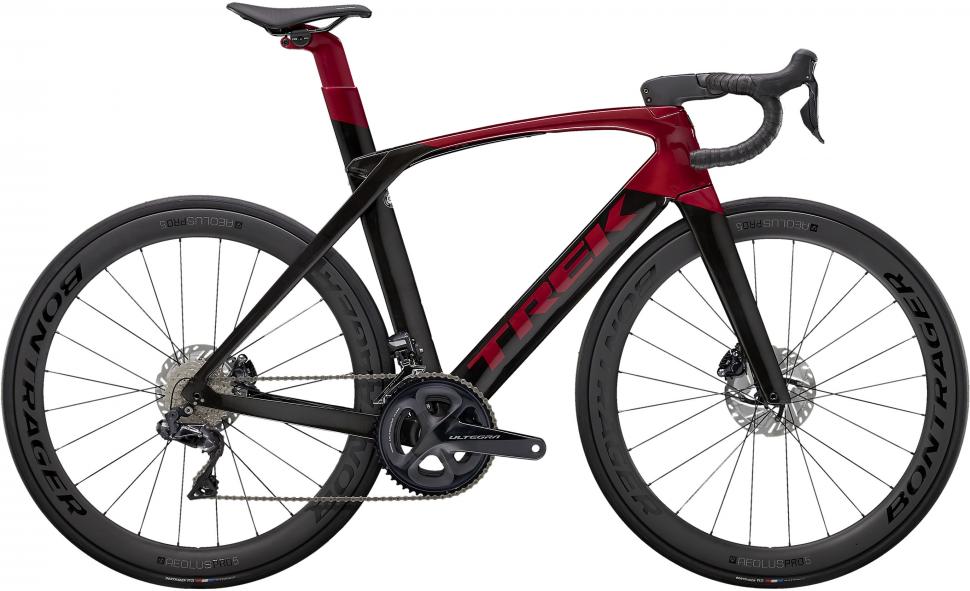
Trek is having an each-way bet on 2021, making the Émonda more aerodynamic while also making the Madone aero bike lighter by using many of the ideas developed for the Émonda.
The Madone SLR models use the OCLV 800 carbon fibre developed for the Émonda, along with the the integrated Bontrager Aeolus RSL VR-C bar/stem, and some models get the new Bontrager Aeolus RSL 37 wheels. Trek says there's a total of 450g to be saved over previous bikes if you pick your components carefully.
The 2021 Madone doesn't look different, though, and you'd have to be pretty sharp-eyed to spot the other main technical change, which is a switch to a T47 threaded bottom bracket instead of the previous pressfit unit.
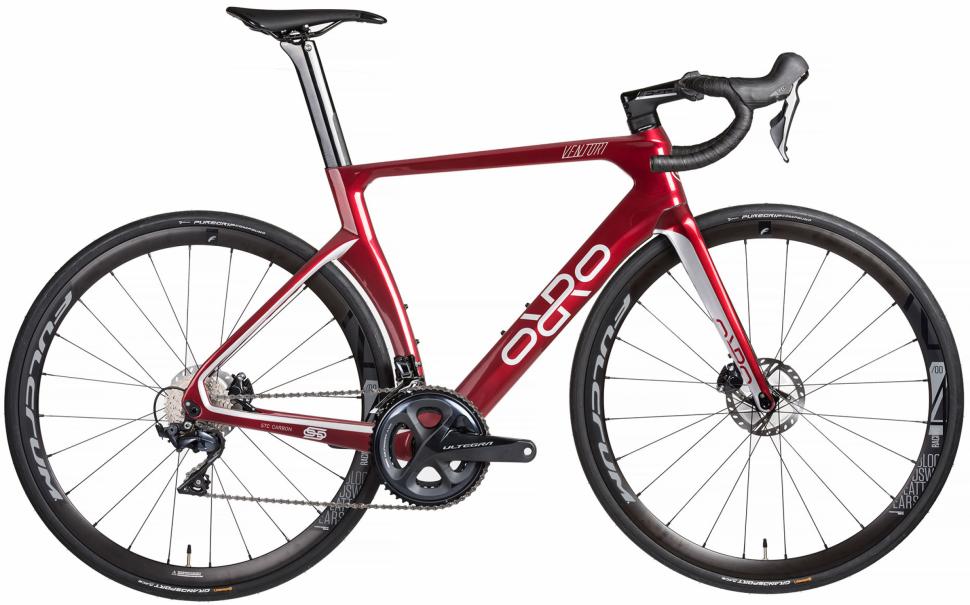
We loved the 2020 version of this bike and for this version Orro haven't messed with the geometry that delivers such a great ride. The big change for 2021 is a new front end with all the gear cables and brake hoses now routed internally. The design is versatile enough to allow use with a vast number of different handlebar/stem systems.
Of the previous Venturi, tester Stu Kerton said "Orro has quite simply nailed it with the Venturi Ultegra Di2 Wind 400. Comfort, speed, handling, feedback and stiffness – you can have it all. And the icing on the cake? It's a looker too!"
"I've ridden a lot of bikes over the last 20 years (41 in 2019 alone), and while a lot of them have been very good, there are probably ten or so that really stand out as brilliant – and the Venturi is one of those."
Why is it so good? It manages to be stiff and exciting without being harsh. "I want to feel everything that is going on from that tiny rubber footprint on the ground, and if I need to take a little bit of a battering to get that then so be it," says Stu.
"The Venturi delivers that in spades, but the carbon lay-up used means it manages to do that while being very comfortable too, without taking anything away."
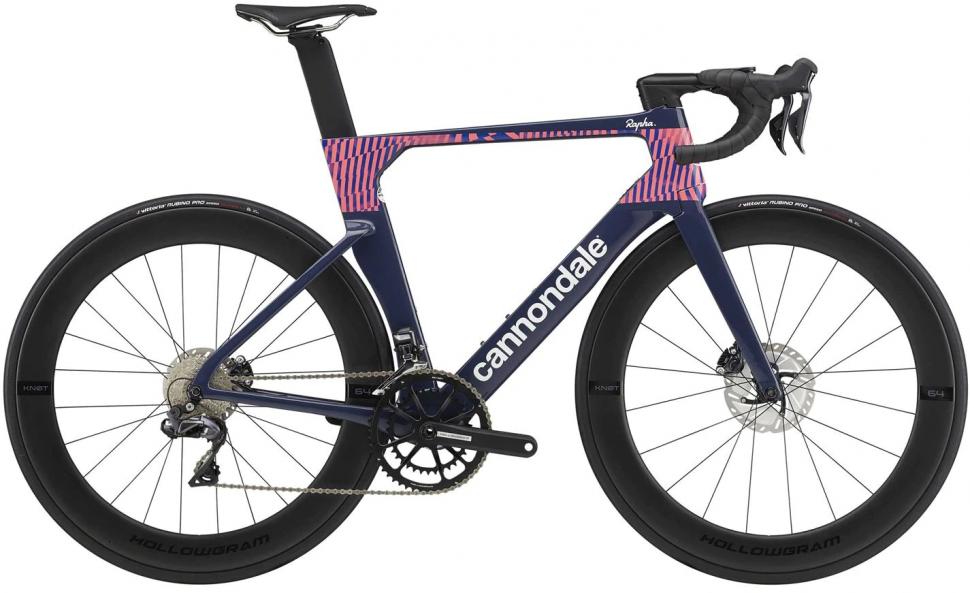
If you want a true aero bike that says Cannondale on the down tube, then the carbon fibre SystemSix is the bike you want.
Cannondale claims that the “SystemSix delivers more speed, to more riders, more of the time” as a result of a frame, fork, seatpost, bar, stem and wheels that are designed to work together as a system to reduce drag. As we often point out, it's close to impossible to assess aero claims without a wind tunnel, but what we can say is that the SystemSix is both eager to get you going and surprisingly comfortable.

The Orbea Orca Aero is substantially unchanged for 2021 from the 2020 model, though that bike did see alterations like tidier cable routing compared to the bike we tested in 2018.
The Orca Aero boasts lots of wind-cheating tweaks. Our tester David Arthur found the Orbea Orca Aero M20Team to be "a fast and great handling aerodynamic road bike with a surprising talent for smoothing out all but the roughest roads. But it is speed, not comfort, that is at the top of the list of requirements for an aero road bike, and that's an area where the Orca Aero feels very competent. It's right up there with the Trek Madone, Cervelo S3 and Canyon Aeroad, as super-quick aero race bikes.
"The handling is a highlight, and helps to set it apart from some aero bikes that can be exceedingly quick but a little lacking when it comes to the way they ride and translate your inputs into actions. The Orca Aero is fun and engaging, putting a smile on your face when you're descending or chasing a friend along an undulating ridge road."
Still, it's odd that the Orca OMX has entirely hidden cabling while the nominal aero version doesn't. You don't have to be Nostradamus to predict a full revamp must be imminent.
You can customise the colour scheme and spec of your Orca Aero too, so if you want to upgrade the wheels, or have yours in pink and orange, fill your boots.

The Bianchi Aria Disc is an aero road bike that offers efficiency, sharp handling and a responsive character, now with the additional all-weather assurance of disc brakes.
The Aria Disc responds keenly to increased effort. Our 59cm sample wasn't especially light at 8.5kg (18.7lb), but it felt direct when you put in the power, a meaty bottom bracket helping to keep everything solidly in place.
The Aria Disc feels as manoeuvrable as the rim brake version, which isn't a surprise given that the geometry is virtually identical. Some bikes designed for aerodynamics offer plenty of straight-line speed but they're a little compromised when you want to flick around. The Aria Disc handles sharply, which gives you options when it comes to darting about a group or avoiding something in the road.
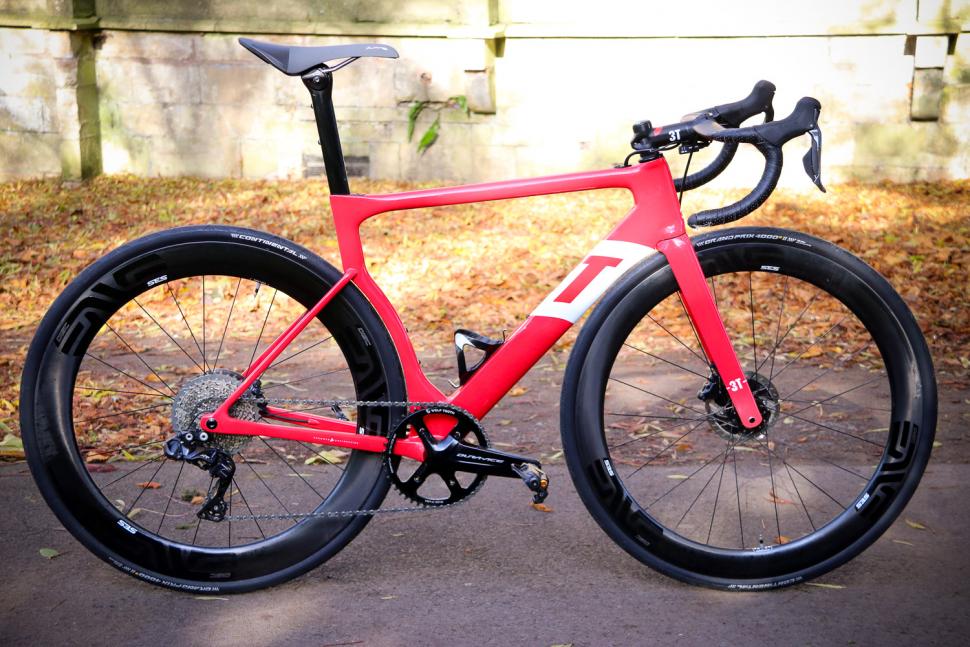
The 3T Strada blew us away. It's a truly stunning bike with breathtaking speed, impressive smoothness and fine handling balance. If this is the future, as some people have speculated, we're sold. This is one of the most exciting road bikes available right now.
The Strada certainly won't be for everyone, and that's fine. There are plenty of fantastic performance road bikes currently available if the 1x11 gearing, disc brakes and tight clearances frighten you. None are as radical as the new 3T, though. What the Strada does with its unique design is offer another choice. It achieves the same aim – of being stupendously fast – but takes a different path to get there.
And if you love the Strada but are put off by the requirement to run just a single chainring, 3T has something for you: the £3,700 Strada Due will take a front derailleur so you can run conventional double-chainring gearing(link is external).

Colnago joined the aerodynamic arms race with the Concept, a full blooded aero race bike that is a serious step forward from the Italian company's first aero road bike, the V1-r.
The Concept has all the capability to dice with the fastest in a race situation. Its stiff frame, deep-section wheels and lightweight give it an insatiable appetite for speed. It's quick in all circumstances: climbs, descents, flat and undulating roads – the bike shines everywhere. This is an exciting bike to ride fast, and like all good aero road bikes it encourages you to ride flat-out.
That firm ride, and frame and fork stiffness ensure the Concept accurately follows your inputs, whether through the handlebar or pedals. It reacts positively whether you're blasting an uphill sprint finish or bombing through a curving descent.
The Concept isn't just for racing. It provides adequate composure and comfort, allowing you to tackle long distance rides at a few notches below race pace and not be dealt a hammer-blow to the lower back the moment the tyres encounter anything but a super-smooth surface. The front end of an aero race bike can often be overwhelmingly harsh, but the special headset and fork steerer tube that Colnago has developed mean the Concept is smoother up front than would normally be expected on an aero road bike.

Buying the Storck Aerfast is a massive outlay, but boy, oh boy do you get one hell of a return on your investment. It's a sub-6.5kg race weapon, with aerodynamics that work in the real world, and it offers comfort levels to challenge most endurance bikes.
Taking plenty of things it has learnt from its astonishingly good Aernario, Storck has pushed the design even further down the aerodynamics route, and what it has created in the Aerfast is a bike that's not only unbelievably fast, but light and stiff too.
If you're in the market for an aero bike, speed is going to be topping your list of priorities, and that's where the Aerfast truly excels. At lower speeds the Storck feels like any other bike to ride, any other superlight bike that is, but as you ride faster it feels like a permanent tailwind is nudging you along, a friendly hand on your back as you watch the numbers climb on the Garmin – with little more effort required than there was 5mph ago. It's a wonderful feeling, and one of which you never tire.
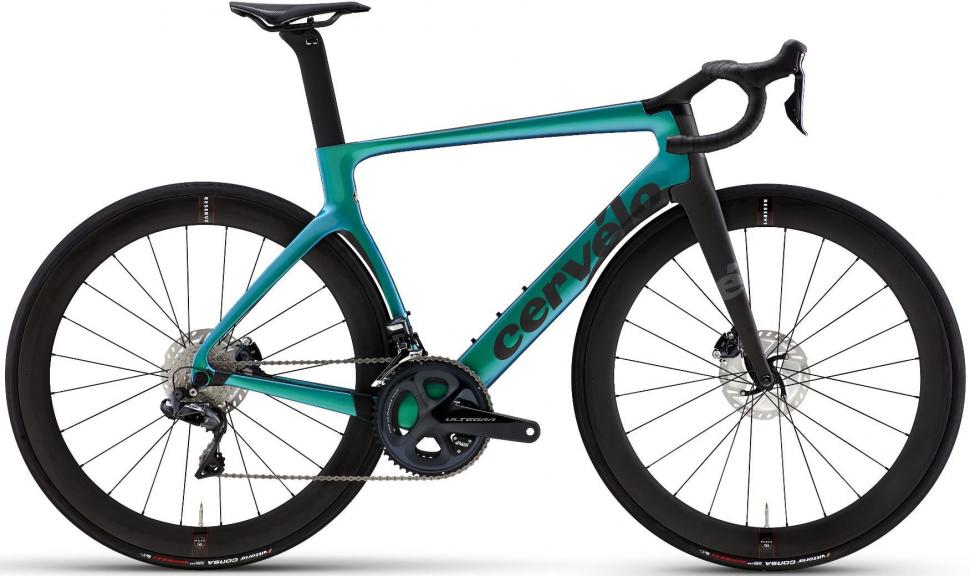
Cervélo says the latest S5 has 5.5 watts less drag that its predecessor thanks to fine-tuning of its aerodynamics and features such as the dramatic V-shaped handlebar stem. It retains some of the most striking lines of any bike, but just to make sure nobody misses its looks, Cervelo offers this startling metallic turquoise colour
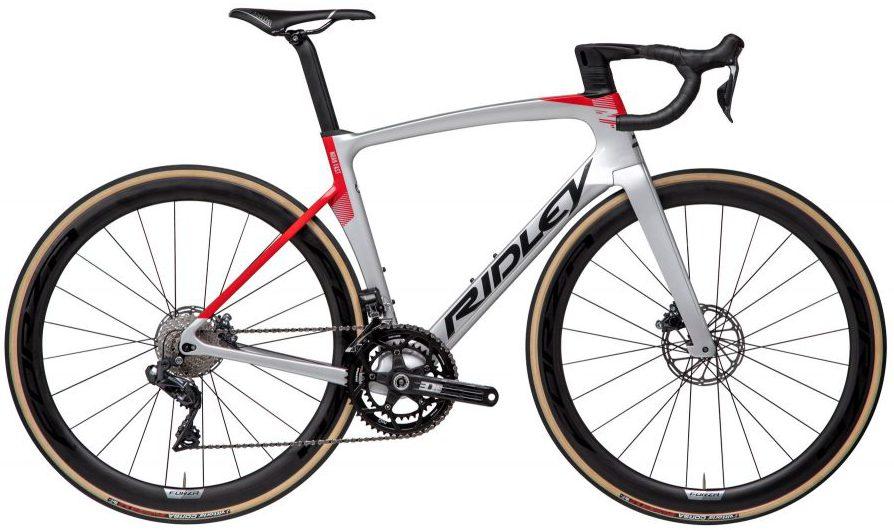
Ridley calls its collection of speed-enhancing aerodynamic features FAST. It includes a tube shape that combines an aerofoil profile with a groove that helps keep the air flowing smoothly over the surface to reduce drag, and a half-moon steerer that provides room for cables to be hidden inside the head tube. The fork has 'F-Wings' at the bottom, which are small fairings designed to improve airflow over disc brakes.

The CAAD13 Disc 105 represents far more than a quick update for Cannondale's aluminium race bike – drag has been reduced, versatility has increased and the ride is more comfortable than ever. This is a really impressive revamp and an excellent alternative to carbon.
Cannondale was, let's be honest, slow to get on board with road bike aerodynamics. The 2017 SuperSix Evo had wind-cheating features, but it was only with the release of the SystemSix that you got the impression Cannondale was serious about improving aero efficiency.
The CAAD13 isn't an aero road bike in the same vein as the SystemSix, but the designers have added several features designed to reduce drag, as they have with the SuperSix Evo on which it is broadly based. The down tube is a truncated aerofoil profile – so it has a rounded leading edge, flattish sides and a squared-off rear. The idea, as ever with a design like this, is that the air acts almost as if there were a long, tapered tail, but without the weight penalty or an adverse effect on handling.
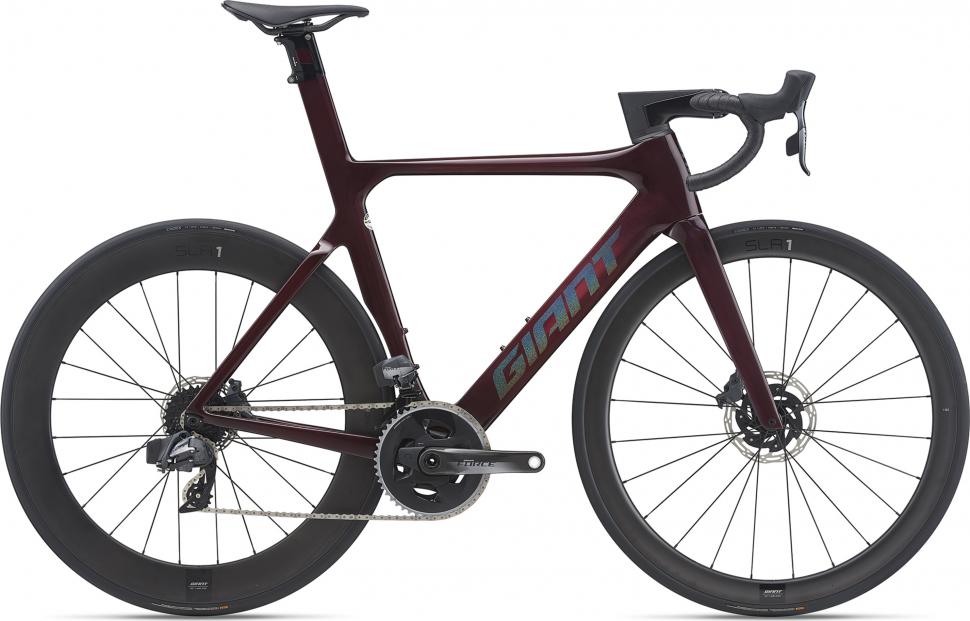
Giant added disc brakes to the Propel Advanced lineup for 2018, claiming that the flagship model, the Propel Advanced SL Disc, has the highest stiffness-to-weight ratio of any bike in its class and a lower drag coefficient at a wider range of yaw angles than the rim brake version.
“One of the key breakthroughs is a new truncated ellipse airfoil shape – a design that lowers drag at a wider range of wind angles than traditional teardrop frame tubing,” says Giant. “Engineers also found that, with proper integration, a disc-brake design can actually improve aero performance compared to rim-brake configurations.”
As well as a stunning paint job, the top of the UK range Propel Advanced SL 1 Disc has a full SRAM Force AXS wireless electronic groupset and Giant's own SLR 1 Aero Disc wheels with a 42mm deep front rim and 65mm rear.
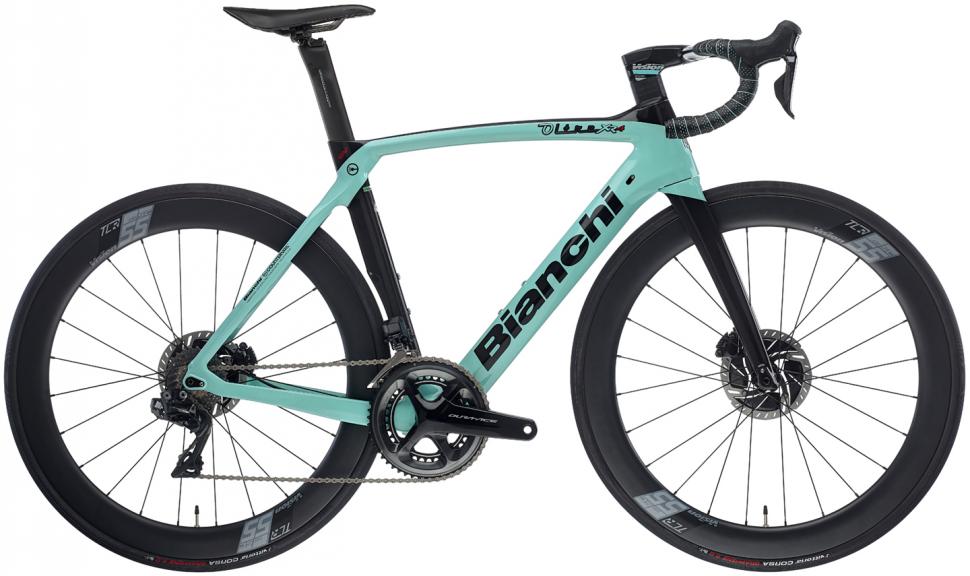
Most of Bianchi's attention for 2021 models went on the stunning new Specialissima lightweight race bike, but you could argue that with its fully-concealed cables and sleek tube shapes, there wasn't much needed doing to the Oltre XR4. Team Jumbo-Visma riders raced the rim brake model to huge success in the shortened 2020 season, and the Bikexchange team has been campaigning the disc-brake version in 2021.
The Oltre XR4 still features Bianchi's Countervail technology, Countervail being "a patented viscoelastic carbon material with a unique fibre architecture that cancels up to 80% of vibrations while increasing the stiffness and strength of carbon frames and forks", according to Bianchi.
Bianchi contends that a frame material that absorbs road shock reduces rider fatigue, allowing you to stay in a your "fastest, most efficient aerodynamic position for longer".
Comments
Post a Comment